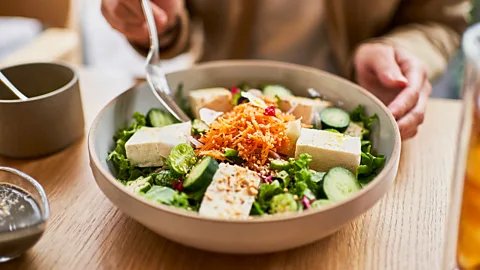 Getty Images
Getty ImagesSlowing down climate change is an immense task, but small individual actions can add up to help reduce emissions.
But it can sometimes feel overwhelming to know where to start. Which steps can actually make a meaningful difference? We have rounded up some of the most impactful actions you can take to live a more sustainable life this year, from eating more plant-based food to reducing your number of flights to buying more second-hand clothes.
Eat a plant-based diet
As a result, it’s widely agreed among the scientific community that to rescue the global climate from ever-warming temperatures, one of the most impactful ways our species can change its behaviour is to eat less meat. According to one UK study, vegans have diets that emit just 25% of the carbon emissions of the most carnivorous meat-eaters, while both vegetarians and vegans have significantly lower water use and cause less harm to biodiversity than omnivorous ones.
 Getty Images
Getty ImagesIn 2022, BBC Earth features editor Martha Henriques and senior journalist Zaria Gorvett decided to put this to the test, and tracked the carbon emissions of their meals over the course of a week. They found that the vegan diet did indeed have lower emissions overall, though on some days of the week the vegetarian diet won. Surprisingly, the amount of food waste generated and the cooking methods used each day also had a sizeable impact.
Take the train instead of flying
If you fly regularly, it’s probably making up a huge proportion of your carbon footprint, so cutting out any flight is one of the best ways to live more sustainably. Using the train, bus or even a car with more than one person is nearly always lower carbon per km or mile. And reducing flying will also likely mean you travel closer to home, reducing carbon even further.
This year one of our writers, Matilda Welin, even tried replacing an airplane journey between London and Sweden with a long-distance bike ride. While it cost more and took far longer than the plane would have, she experienced an “unforgettable journey” and enjoyed seeing the world “at human speed”. She now feels prepared to do shorter long-distance bikes rides more often, replacing car and train rides.
Buy fewer clothes
 Getty Images
Getty ImagesReduce your carbon paw print
We love our pets. But research shows keeping animals is not always the most environmentally friendly thing to do. Take pet cats. They can generate over three tonnes of CO2 over the course of their life – equivalent to driving a petrol car 12,070km (7,500 miles).
A simple – but perhaps surprising – way to make your beloved pooch more sustainable is to switch to recycled dog poo bags, as opposed to bags made from virgin plastic or compostable alternatives, which have a surprising climate impact.
Read more about how to make your pets more environmentally friendly.
Consider heating alternatives
If we’re going to switch off our gas boilers – or at least turn the thermostat down for now, what can replace this source of heat to keep homes safely warm?
Tapping that tantalising waste heat is often a district or city-wide project. But lower-carbon options are also emerging for individuals.
 Getty Images
Getty ImagesThe International Energy Agency estimates that by 2030, heat pumps could reduce global CO2 emissions by at least 500 million tonnes, or the equivalent of the annual CO2 emissions of all cars in Europe today.
Invest in a greener pension
When discussing sustainability, we don’t often think of our personal finances. But how we choose to save, invest and spend our money can make a surprisingly big difference to the climate.
 Getty Images
Getty ImagesCut down on single-use plastic
Buying loose vegetables is a great way to help rid your weekly shop of plastic, but often you still need to bag them in store – and the bags available are often plastic. The solution? Bring your own muslin reusable produce bag.
Perhaps also have a think about where you buy your milk. Milk vending machines are popping up on farms all over the UK and the trend is beginning to catch on in North America too. You bring your own glass bottles (or buy one there), and fill up with fresh milk – eliminating the need for plastic packaging.
You could also start shopping at a zero-waste store, where you can refill your bathroom and plastic-free cleaning products. Once you’ve got a tin (either buy one from the store or reuse a biscuit tin), a soap dispenser, and a spray bottle, you just reorder the products as and when you need them, and they’re shipped in paper packaging.
Plastic utensils are hard to recycle (at least in the US). So think twice about whether you really need them, or carry around a portable utensil kit, which usually come in neat carry cases. This applies to straws too. Paper straws aren’t necessarily better for the environment, so you could include a reusable straw in your kit too.
